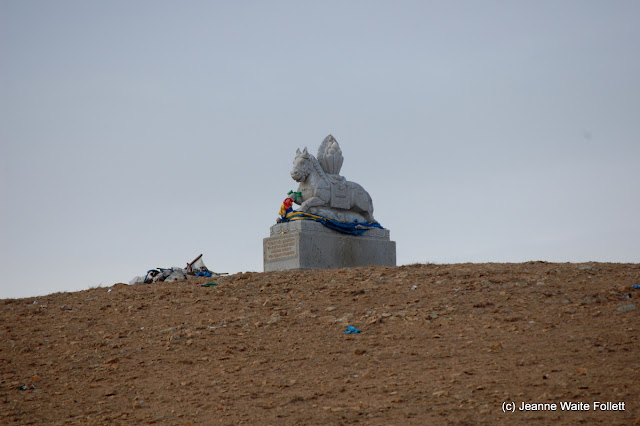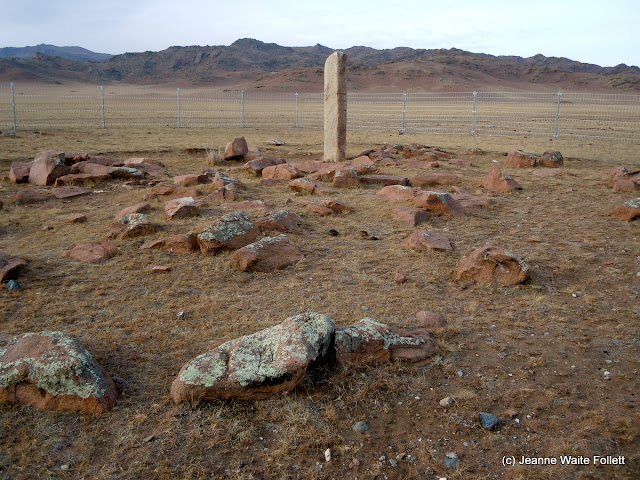When last we saw our
intrepid adventurers—before the horrors of multiple computer disasters and
restoration chores on this end—they were bundled up against the cold northern
Mongolian wind at the exclusive Ashihai Tourist Camp and waving goodbye to the
staff who had assembled to see them off.
Being here is worth the cost of
the trip,” says Cap. I agree
wholeheartedly, though the best part for me was the day trip from the Ashihai
tourist camp and the visit with the Mongol herders. And that cup of salted yak
milk tea.
They are on a time
schedule now, as Cap is anxious to get back to Ulaanbaatar in time to attend a
meeting at 2 P.M. Saturday afternoon.
We catch up with them in nearby Mӧrӧn, not far from Ashihai but a couple
hours closer to their destination, where they have stopped to spend the night.
Now, we’re in Murun, or Moron, or
Mӧrӧn—take your pick, as long as you pronounce it Muroon. From now on, I’m
going with the Moron spelling, just for kicks and because I’m still reading From Mӧrӧn to Moron.
My room isn’t quite ready, so I
wait in the lobby of the hotel where we had lunch a few days ago, looking at a
large map. I have a hunch there’s more
to the name of this hotel than meets the eye.
There’s a sign that says 50/100.
The longitudes and latitudes on the large map are too small for me to
read, so I take photos and hope to enlarge the numbers later.
 |
| This little girl is so focused on the cartoons playing on the TV above me that she has no idea I'm there. |
Turns out there’s no need because
as soon as I walk up the stairs to my room, there are signs everywhere: n 50°” e 100°00” Hotel. And
there you go, the latitude and longitude of this hotel that’s named 50 Degree
100 Degree Hotel. Frankly, the old name
that everyone still uses, Edelweiss, is much easier.
The adventure for the day is a
visit to the Deer Stones. I was
absolutely blank on what deer stones were, but I suspected something along the
lines of cave art.
The short drive is where Chimdee
decided to have some fun and he pushed the pedal of the metal as we rocketed
across the flat plain. A caveat:
No livestock were harmed during the speed-of-light crossing.
 |
| Choose another. |
Out in the middle of nowhere is a
small shack used by a volunteer caretaker during the summer tourist months, a few signs, and a fenced area surrounding some stones sticking up
in the air and some piles of rocks. I am
immediately enthralled and wish I had a guide book that would tell me more in
depth than I glean from Yusuf. It is not
Yusuf’s fault; it’s mine. I simply don’t
know enough about this site to ask the questions that would satisfy my
curiosity.
 |
| Some of the deer stones in this complex. |
Most often carved from granite or greenstone, these ancient
megaliths from the Bronze Age most likely depict events from a person’s life,
though they are not considered to be gravestones as no human remains have been
found at the sites. Most likely, they
represent shamanist rituals, as animal remains have been found under the
stones. Other theories suggest they are
simply art.
 |
| There are many theories as to the purpose of these mounds, but they are now considered by many to be altars. |
 |
| Yusuf and Patti amid the deer stones. |
Stones with stylized reindeer are prominent in southern Siberia
and northern Mongolia. Of the 700 known
deer stones worldwide, 500 of them are in Mongolia.
 |
| Note what appears to be a belt or sash with bow, axe, and other tools. |
Like gers, the carved faces are oriented to the east, to
catch the morning sun.
 |
| Note the face at the top of the deer stone. This is considered very unusual. |
While I lingered at this tallest of the deer stones, a break appeared in the clouds. Look what happened.
This is from Lonely Planet:
Found across Mongolia,
deer stones are markers from the Bronze Age and there are several theories
about their existence. The ancient steppe
tribes believed that after death the soul ascended to the sky on the backs of
deer. The deer carved on the stones
appear to be representational of this act.
However, since human
remains have never been found near these stones, they do not appear to be
gravestones, but rather serve some sort of religious or spiritual purpose. Many deer stones are also carved with a belt,
from which hang various tools including axes and spears. These accessories would be required to successfully
navigate the afterlife.
\
The drive back to Moron was at a moderate speed because Cap had a tête–à–tête with Chimdee. It was also populated with speed bumps in the form of curious livestock.
 |
| Having had one successful tête–à–tête this afternoon, Cap approaches the locals to attempt another. |
Other photos from the drive back to Moron:
 |
| A monument to horses on a nearby hill. |
 |
| Moron is laid out in grids with wide streets. |
 |
| This map shows several routes. Ours will be from Lake Khuvsgul in the north to Moron, across to Bulgan and east to Erdenet. Our destination is Ilaanbaatar in the far east. |


































Thank you, Jeanne. This is another interesting post. In the small story that you have a picture of, do you know what 3500 - 4000 BP means. I don't think it is a typo. Would it have to do with a different calendar like the Chinese?
ReplyDeleteI Googled it. This is from archaeologist expert K.Kris Hirst:
ReplyDeleteBP when placed after a number (as in 2500 BP) means "years Before the Present". Archaeologists generally use this to refer to dates that were obtained through the radiocarbon method, although not exclusively.
The advantage to using BP is it avoids the whole philosophical debate about whether in this multicultural world of ours it is better to use A.D. and B.C., which are explicit references to Christianity, or to use C.E.
(Common Era) and B.C.E. (Before the Common Era), which still, after all, use an approximation of Jesus Christ's birthyear as a starting point.
The only trouble with using BP is--the Present year, of course, changes every twelve months. Since the BP designation was at least originally associated with radiocarbon dating, archaeologists chose the year 1950 as 'the present'. Radiocarbon dating was invented in the late 1940s, and, also, atmospheric nuclear testing was begun in the 1940s, which makes, at least the theory goes, radiocarbon dates after 1950 virtually useless, anyway.
"Don't care for the road you are on? Choose another." Great lines to go with the photos of the road. The Deer Stones certainly are a cause for thought about those who created them so long ago! Wonderful and fascinating .. even more so than when we were actually there. Great post. Fun post. Cap and Patti ..
ReplyDeleteFrom the Bronze Age. I have trouble contemplating a time so far back.
ReplyDelete